Volkswagen e-Golf

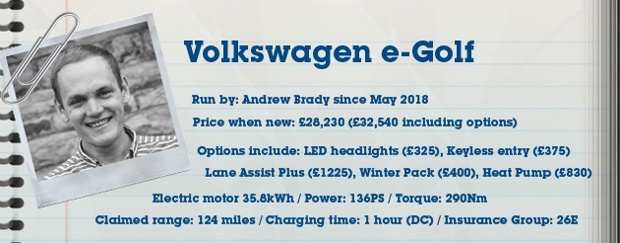
- The all-electric Volkswagen e-Golf arrives
- Can the Volkswagen e-Golf cover longer journeys?
- How does the Volkswagen e-Golf compare to the Nissan Leaf?
- I'm becoming an electric car evangelist
- What options shouldn't you choose?
- What options should you choose?
- How far does the e-Golf go on a single charge?
- Cracking times for the Volkswagen e-Golf
- How good is the charging infrastructure?
- How can you maximise the range of an electric car?
- Where are all the Volkswagen e-Golfs?
- A silent killer?
- Why is Tesla the daddy of electric cars?
- Goodbye, my electric friend
The all-electric Volkswagen e-Golf arrives
Just how usable is an electric car every day? Andy's getting to grips with the UK's EV charging infrastructure.

Date: 29 May 2018 | Current mileage: 300 | Claimed range: 124 miles | Actual range: TBC
Electric cars are the future, apparently. That’s why Jaguar has just launched its electric I-Pace, Audi’s e-tron is set to go on sale later in the year and Tesla appears set to take over the world. But many of us are reluctant to make the switch, concerned about just how usable an electric vehicle is every day.
Which is why I'm going to run one for the next seven months. Just how good is the UK’s electric car charging infrastructure? Will the e-Golf’s 124-mile estimated range prove to be long enough? What will happen to the range in winter when things like lights and heating are required?
We hope to answer all these questions between now and December. With just 300 miles on the clock, the e-Golf is fresh off the truck and is already impressing those in the Honest John office. It’s like a Golf, and that’s a good thing. The interior is upmarket, while it doesn’t feel weird and wacky in a divisive way like some electric cars. Basically it's a Golf - one of our favourite family hatchbacks - but without a noisy engine.
Our e-Golf’s stacked with options, bringing its total retail price (before the Government’s £4,500 plug-in car grant) to £37,040. These include Lane Assist Plus (£1,225), LED headlights (£325), a heat pump which recycles heat from the ambient air and drivetrain components (£830), winter pack (£400), active info display (£495), keyless entry (£375), carpet mats (£85) and metallic paint (£575).
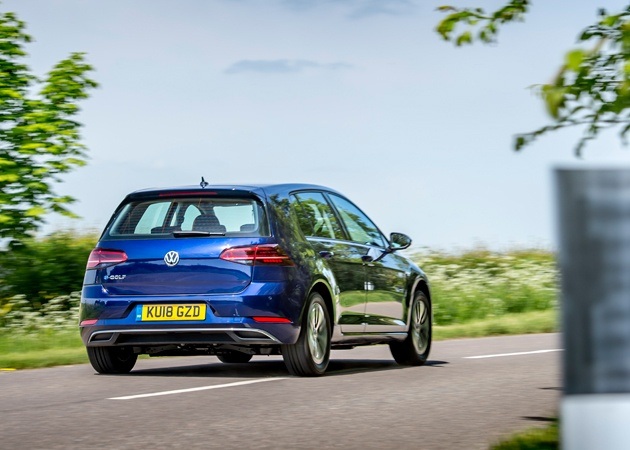
Revised for 2018, the e-Golf now boasts more power than before - 136PS helps it hit 62mph in 9.6 seconds. It's also got a 50 percent greater range than its predecessor. Although it will officially return 186 miles in NEDC tests, Volkswagen claims a more realistic 124 mile range.
Charging’s going to be an issue - we haven’t got a charging point at the office, nor have I got one at home. As such, we’re relying on public charge points for the time being, along with charging using a standard three-pin plug. While fast motorway chargers can boost the Golf to 80 per cent in just 45 minutes, using a standard 230v supply takes as long as 17 hours for a full charge.
That's obviously not ideal, which is why we're going to be looking an installing a wallbox at the HJ offices. Doing so will cut charging time to around five hours - meaning I can top up the e-Golf with electricity comfortably before home time.
Before that happens, I'm going to be getting used to clogging up the EV charge points at nearby Peterborough Services. Will this sour my time with the Golf? I'll report back...
Can the Volkswagen e-Golf cover longer journeys?
Andrew attempts a longer journey in the electric Volkswagen e-Golf. It all goes surprisingly swimmingly.

Date: 12 June 2018 | Current mileage: 964 miles | Claimed range: 124 miles | Actual range: 160 miles
Whenever car manufacturers are plugging their new plug-in vehicle (pun intended), they always quote various stats about how the majority of people never drive more than a certain amount of miles a day. The point is, should you really be so dismissive about an electric car with its 120-mile or so range if you only ever drive to work and back while popping to the shops occasionally?
And it’s true. Even though my commute is a fairly hefty 90-mile or so round trip and I regularly drive to airports around the South East, it’s still rare that I have to complete a journey that can’t be undertaken in an electric car.
For its first week or so on the Honest John fleet, the e-Golf spent a lot of its time in the car park, save for the odd lunch run into the next town. I just didn’t have any confidence that I could use it for longer journeys and a steady stream of petrol and diesel test cars meant it was easy to shy away from electric power.
The UK launch of the new Mercedes-Benz A-Class in the Cotswolds gave me reason to travel further afield in the e-Golf. The hotel was about 100 miles from our office - something that should be doable on one charge - and I’d phoned ahead to check that I’d be able to plug the Volkswagen in once there.
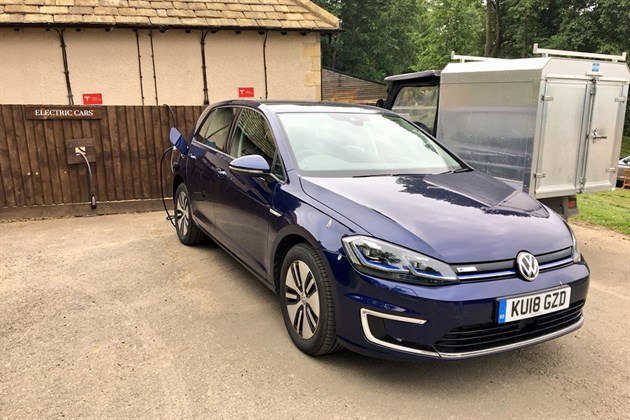
Andrew's been surprised at all the places that offer electric car charging
I’d love to have a story to tell about what a challenging journey it was - bad weather, heavy traffic and unwanted diversions all playing their part in leaving me being stranded on the side of the road without electricity - but it wasn’t like that. I got in the car, set off, and arrived at my destination a few hours later feeling very relaxed with the Golf showing 60 miles of range left.
Once at the hotel, I plugged my car in using one of their wide range of charging leads and a few hours later it was fully charged.
Now, the e-Golf has an official NEDC range of 186 miles but Volkswagen - keen to remain whiter than white - emphasises that 124 miles is a more realistic range expectation. I’ve found on a few occasions now that that’s easily beatable, as long as you’re gentle with the throttle and crank up the regenerative braking to pump electricity back into the battery.
My confidence is building as the initial range anxiety declines. That’s good, as I’m still charging using an extension lead at home and we’re nowhere nearer to installing a charge point at the office. Maybe it’s time to complete a properly long journey in the e-Golf, however...
How does the Volkswagen e-Golf compare to the Nissan Leaf?
A convenient test of the new Nissan Leaf represented to perfect opportunity for us to compare it with our Volkswagen e-Golf.
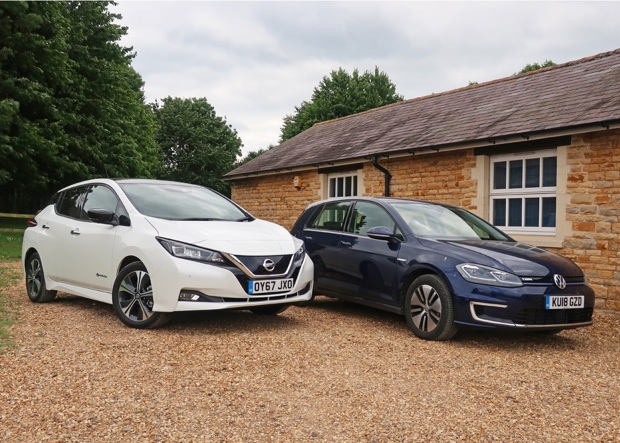
Date: 26 June 2018 | Current mileage: 1240 miles | Claimed range: 124 miles | Actual range: 160 miles
I have to confess, most of the time I enjoy a luxury that most electric car owners aren't able to. I have access to the many cars we have on test every week, meaning if I have a long journey to make, I can swap the e-Golf for something with a petrol or diesel engine.
Before you start searching for the comments box (there isn't one, sorry), let me explain why I'm telling you this. Last week, we had a Nissan Leaf in for review - giving me little choice but to spend a full seven days with an electric car. Not only did this provide real life experience of running an EV, it also represented the perfect opportunity to compare the e-Golf with arguably its most direct competitor.
First impressions fall in favour of the Golf. While the new Leaf is much improved inside compared to its predecessor and feels more like a 'normal' car than before, it's just not up to the quality of the Volkswagen. The e-Golf feels rather premium, with a slick infotainment system and lots of quality materials.
I have noticed that the seats in the Golf do make me longing for fairly frequent breaks on longer journeys. That's not a huge issue... you have to stop regularly to charge it anywa, and most electric car drivers won't make many long journeys. But it's not a problem the Leaf has. Thanks to Nissan's clever Zero Gravity Seats, developed quite literally using rocket science, I felt as fresh as a daisy after circumnavigating the M25 for a weekend away in Berkshire.
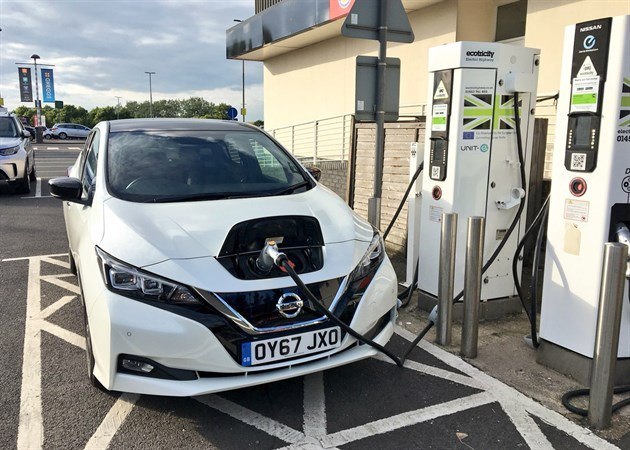
A week of zero-emissions driving went extremely smoothly
The Leaf's bigger boot meant carrying a car full of friends and their luggage wasn't a problem for the electric car and its 168-mile range was plenty for the 75-mile drive. It probably would have been enough for a return journey, but I found an NCP car park in Reading town centre with four charging points going free. In fact, it's range where the Leaf pips the Golf. Under real-life driving, the Golf can cover around 124 miles, Volkswagen claims - although, as previously reported, that's fairly easy to beat.
You won't be achieving these range figures if you're heavy with the accelerator, but the Leaf will hit 62mph in 7.9 seconds. That's more than a second and a half quicker than the e-Golf. But you'll have to press the Leaf's 'eco' button if you want to increase range - and that seriously hampers acceleration.
Incidentally, the new Leaf's clearly quite a distinctive car. Following my return journey, not one but two industry colleagues messaged me to say they'd seen the Leaf on the M25. One said I was 'causing congestion'... I blame the electric car mindset I'm now well and truely in, opting for using minimal battery rather than reaching my destination in record time.
So, Leaf or e-Golf? On paper, the Leaf's better in many ways. It's quicker, has a more useable range and is more spacious. But my money would go on the Golf. The Volkswagen's interior is lovely - the same can't be said for the Nissan's - and it's more enjoyable to drive, if slower. The second you get into the Golf it feels like any other car, with just silent running alerting you to its eco credentials. The Leaf shouts about it more, yet the interior's fairly drab. And don't get me started on the ancient infotainment system.
Whether you choose the Volkswagen e-Golf, Nissan Leaf or any other electric car on the market, you'll enjoy the perks offered by an electric car such as instant acceleration and silent running. As my experience is proving, you may also be surprised by just how easily an electric car slots into your life.
I'm becoming an electric car evangelist
Andrew's getting all defensive about the Volkswagen e-Golf. You'd probably be better asking him about Brexit...

Date: 10 July 2018 | Current mileage: 1725 miles | Claimed range: 124 miles | Actual range: 155 miles
I was recently at an airport making small talk with a group of motoring journalists. Small talk is something motoring journalists aren't very good at. We stick to what we have in common, which means conversation usually evolves around cars. Which tends to get a bit boring after a while, but that's another story.
Anyway, the conversation turned to the cars we'd driven to the airport. Not only is it a good opportunity to compare notes on the latest test cars, it's also more interesting than talking about the weather.
I said that I was in my electric Volkswagen e-Golf, and instantly one of my peers started with the whole "I couldn't run an electric car" thing. "Until electric cars get a longer range, they won't catch on," he said. It's all stuff I've heard before. Many times.
So I got a little defensive about the e-Golf. If you've been reading my reports, you'll know that I really like the e-Golf. And it fits into my life perfectly.
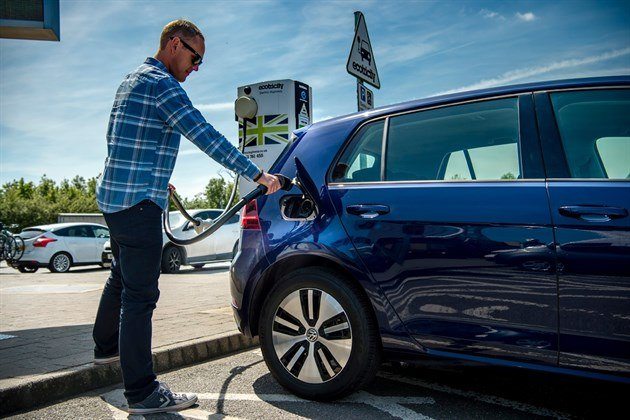
Andrew resorted to hanging around electric charging points so he could tell the world how good the Volkswagen e-Golf is...
It's not like I only cover short distances, either. I drive nearly 100 miles a day commuting to the office, and I regularly have to go further afield to drive new cars.
But I'm finding that 160 miles can be eked out of the e-Golf fairly comfortably and, with most of my destinations being in the South East, it's rare that I have to travel further than that. If I do, I can plug it in for a fast charge while I have a coffee.
"I just love an engine," my nemesis said, as he evidently ran out of reasons why the e-Golf wouldn't fit in with his life. You could probably describe me as a 'petrol head' (although I'd rather you didn't), yet I still love driving an electric car day-to-day. The instant torque, the lack of grumbly diesel engine, the not having to visit petrol stations. What's not to like?
The conversation swiftly moved onto a no-deal Brexit. A safer topic.
What options shouldn't you choose?
If you want to buy a Volkswagen e-Golf like mine, it will cost you a whopping £37,040. Or will it..?

Date: 24 July 2018 | Current mileage: 1980 miles | Claimed range: 124 miles | Actual range: 162 miles
If you want to buy a Volkswagen e-Golf like mine, it will cost you a whopping £37,040. Sorry, that was a bit clickbait of me. It will actually cost you a smidgen over £32,500 by the time the Government's contributed £4500 as part of its Plug-in Car Grant. That's still quite a lot of money for a car that can only cover around 160 miles in one go.
My car's fitted with quite a few options, though - including quite a few you probably won't need. Take the £1225 Lane Assist Plus, for example. As well as nudging the steering if you venture out of your lane, it also includes a host of other safety equipment.
Dynamic light assist will 'mask' other vehicles when you have full beam on, meaning you don't have to dip your headlights to avoid blinding other motorists. Rear traffic alert will alert you if you're reversing out of a parking space when cars or pedestrians are approaching, while traffic sign recognition alerts you to the speed limit.
All clever stuff, but none of it essential. That's an easy £1225 saved. Deleting this option also means you won't need LED headlights, which saves a further £325.
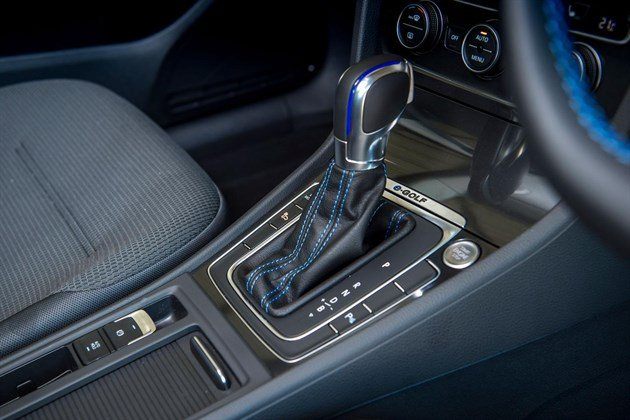
Our e-Golf features more than £4,000 of options. But do you actually need any of them?
There's a winter pack, for £400, which includes headlight washers, heated front seats, heated windscreen washer jets and low washer fluid warning lights. At the moment, I'm reluctant to use such features as they're a drain on the battery - so that's another £400 saved (ask me when winter arrives if I still think I could manage without this option).
Next there's the heat pump. This is an interesting one, as it's an £830 option that you won't really notice working. Essentially, it recycles heat from the ambient air as well as waste heat from the car's drivetrain. The result is slightly improved efficiency in ambient temperatures and up to a third more range in extremely cold conditions.
If you live in Norway, it's probably a worthwhile option. But Volkswagen quotes a temperature of -7°C for this to work best and it's never that cold in the UK. Easy, another £830 off the price.
Other options I could comfortably manage without include the active info display (£495) and keyless entry (£375). Let's not go too far, though... £85 carpet mats are worthwhile to protect the carpets (although you could probably get them cheaper elsewhere), and I'd rather not give up the £575 metallic paint.
That brings down the price of the e-Golf to £28,890. Still expensive, admittedly, but think of the money you'll save on fuel...
What options should you choose?
So which option boxes should you tick when speccing an e-Golf? Andy has a look at what he'd spend all his imaginary money on.
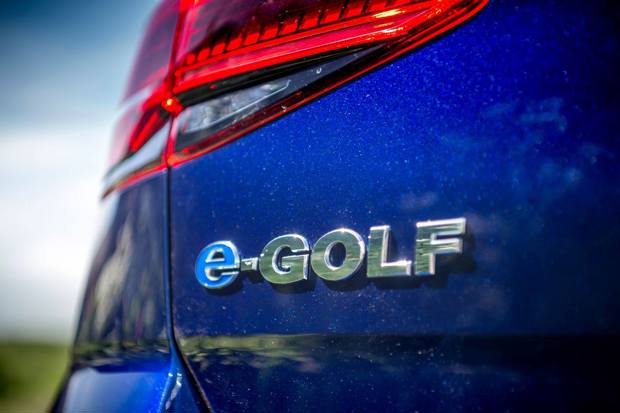
Date: 7 August 2018 | Current mileage: 2136 miles | Claimed range: 124 miles | Actual range: 168 miles
I covered in my last e-Golf update the options I could manage without... and concluded that you didn't really need any of them other than mats and metallic paint.
So which option boxes should you tick when speccing an e-Golf? For a start, I'd probably save money by choosing the £280 Black Rubin paint because I once saw it on a GTD and thought it looked fantastic.
Alternatively, I'd be tempted by the £570 Peacock Green paint because there aren't enough metallic green cars on the roads and it's still £5 cheaper than our Atlantic Blue test car.
Colours are a personal thing, though. As is whether you'd prefer cloth or leather seats. Some people detest leather seats - hot in summer, cold in winter, but I think they'd make the e-Golf feel more premium than it is with cloth.

How much better would this look with cream leather seats?
Leather's a hefty £2115 option, but that includes heated front seats and you'd probably get some of that initial investment back at resale time (and PCP deals will take that into account). I'd take mine in Shetland cream as a contrast to my Black Rubin or Peacock Green exterior, thank you very much.
My car's fitted with parking sensors, but I'd prefer a camera. Yes, I know, we've managed for years without reversing cameras or sensors, but I like being able to see what's behind me when I'm reversing into a parking bay. And, at £340, it's one of the better value options available.
Finally, while I'm splashing the cash, the £550 Dynaudio premium sound system appeals, as I enjoy listening to music while driving. The standard audio system's fine, but I'm saving money on fuel so can justify some fancy speakers.
For an extra £3285 I've turned the e-Golf into a premium car with leather seats, a fancy sound system, a reversing camera and attractive metallic paint. Should you spec these things? Well, none of them are strictly essential, but it's where my money would go. And it's still comes to less than the cost of options on my e-Golf.
How far does the e-Golf go on a single charge?
The e-Golf undertakes its longer single-charge drive. How far can it go? Andrew finds out.
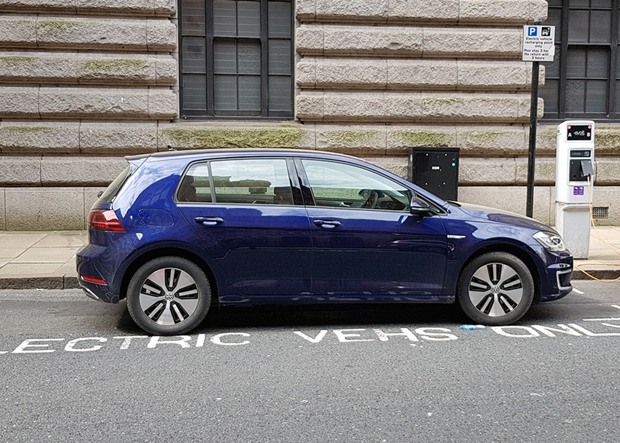
Date: 21 August 2018 | Current mileage: 2536 miles | Claimed range: 124 miles | Actual range: 171 miles
If you buy a Volkswagen e-Golf, how far can you reasonably expect it to travel on a single charge? Well, following my longest drive I can tell you. It's about 171-miles. But there are some problems.
Keen to find out just how far the e-Golf will go on a single charge, I decided to take it to Birmingham. I had to visit the city for some work-related things on a Monday morning. And I decided that the time had come to push the e-Golf to its limit. The distance from our office to Birmingham is 75-miles and I was determined to get there and back on a single a charge. Would the electric Volkswagen be up to it?
Climb behind the wheel of the fully charged e-Golf and the trip computer instantly puts your mind at ease with a cool, calm promise of 186-miles. 186 miles? That’s loads. More than enough to cover the 150-mile roundtrip. As a result, my confidence (along with the air con) was in full flow as I pulled away from the office car park and onwards towards the West Midlands.
As I arrived in Birmingham the e-Golf was looking good, with the trip computer boasting a respectable 117-miles. Admittedly, the roads were free of traffic and I'd used regenerative breaking and cruise control on the motorway, but the Volkswagen had got me to my destination in tip top shape. I had a few errands to do in the city, but my back-up plan was to park at an EV charging station and boost the battery if I felt the e-Golf wasn’t going to get me back. Unfortunately plan B was kicked into the long grass when I found that many of the EV charging points in Birmingham’s multi-story car parks are designed for extremely small cars.

Charging an electric car in Birmingham is difficult, owing to the fact that many of the parking spaces are too small for two modern-sized cars
Birmingham does have larger car parks and on-street EV charging points, but by mid-morning these were all full. And those that weren't occupied were faulty. After a morning shuttling around the city, the e-Golf's range had dropped to 99-miles. Surely the 20-odd mile cushion would be enough to get me back to the office in air condition comfort? How wrong I was.
Crawling along the now clogged up M6 back towards Northamptonshire it became clear that the e-Golf was not going to fulfil its side of the bargain. Indeed, 10 miles into my 75-mile drive back and the trip had changed its mind multiple times before settling on a final figure - 60 miles. This meant I had to make some significant compromises to claw back some mileage and cover the 65 miles needed to get to the finish line.
The air con was the first thing to go. Not only did this add 15-miles to the range, but it also transformed the cabin into an industrial oven. The UK was in the middle of a long, hot summer and the outside temperature was 30 degrees. The ventilation system cooled the interior a little when on the move, but in traffic I was hotter than a packet of extra strong mints left in the sun.
By the time the M6 traffic cleared, the 15-mile boost had been reduced to virtually nothing and I had to cut my motorway cruising speed to 60mph and use the brake regeneration at every opportunity to reclaim some valuable miles. However, despite the hot and uncomfortable cabin, I felt cool relief as the e-Golf rolled into the car park. And with a couple of miles to spare. So there you have it, 171-miles on a single charge is possible. It's hell on wheels, but entirely possible.
Cracking times for the Volkswagen e-Golf
How easy is it to find a replacement windscreen for the Volkswagen e-Golf? Andrew was all too keen to find out.

Date: 4 September 2018 | Current mileage: 2891 miles | Claimed range: 124 miles | Actual range: 162 miles
Keen to experience electric motoring, HonestJohn.co.uk editorial director Dan Harrison borrowed my e-Golf for a few days recently and it came back with a chipped windscreen. A road on his commute was being resurfaced and a car travelling too fast in the opposite direction flicked a stone up at the Golf's windscreen.
All too aware of how quickly a chip can turn into a crack, I was straight onto the phone to get the chip repaired. A man in a van appeared a day later, telling me that a new windscreen would be required because the chip was in the driver's eyeline.
But there was a problem - he'd brought what he thought was a suitable windscreen with him, but it wasn't in fact the right one.
At that point, thoughts about how the e-Golf must require a different windscreen to a petrol or diesel Golf rushed into my mind. Perhaps it's a special, lightweight windscreen designed to be more efficient? Or perhaps it's more pedestrian-friendly for those occasions when other road users don't hear the Golf approaching?
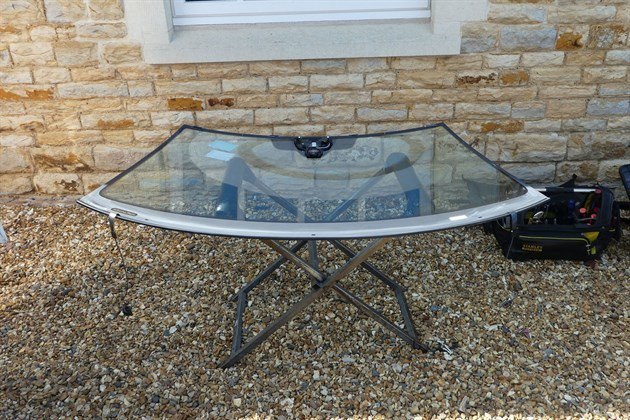
A shiny new heated windscreen - the right one this time
But that's not the case - it's the same windscreen as any other Golf. Except it's heated, and the man had brought an unheated one.
A day later he returned and the windscreen was replaced within the hour. It was all very easy.
Cracked windscreen aside, Dan came back full of enthusiasm for the Golf, praising its refinement and how relaxing it is to drive. He could comfortably drive home and back to work on a Golf, plugging it in for a charge at the office using our trusted 'lead through the window' technique.
Which reminds me, I really ought to look at having a proper charger installed...
How good is the charging infrastructure?
We love the Volkswagen e-Golf but the infrastructure isn't quite there yet.
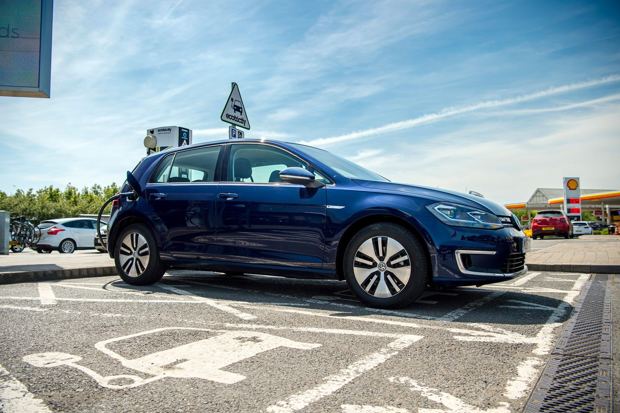
Date: 18 September 2018 | Current mileage: 3111 miles | Claimed range: 124 miles | Actual range: 158 miles
We've established that I can cover 160 miles from a single charge in the e-Golf, and most of the time that's plenty. I rarely drive more than that in one day but, occasionally, I need to use public charge points to top up the Golf so I'm not left stranded.
If you haven't used a public charge point, in theory it's fairly simple. You can use an app such as Zap-Map (or even the car's own in-built navigation system) to find suitable charge points. There's quite a few of them, so finding one shouldn't be an issue unless you're somewhere particularly rural.
One of the biggest problems is that there are numerous different companies operating different chargers. This means they all work in different ways, with many needing you to download the appropriate phone app to operate them.
I recently visited Peterborough city centre where, for the first time, I planned to use a Pod Point charger. Finding it was easy - close to the centre with free parking, perfect - and it wasn't being used (or, even worse, blocked by a diesel or petrol vehicle). I downloaded the app, filled in my details and plugged the car in. It looked like it was working so I locked the car and walked away for a spot of sightseeing.
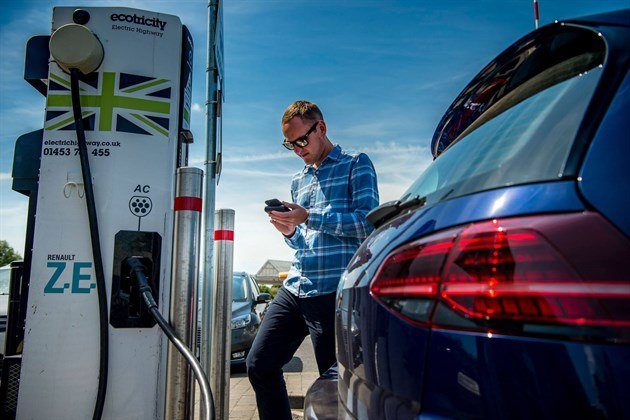
Different chargers require different apps to use them. Which is a faff.
On my return, I found that the range hadn't increased at all. The car hadn't been charging. The app said it was, so I'm not quite sure what went wrong. I sent Pod Point a message on Twitter to find out why it hadn't worked, but I didn't get a response.
Pod Point's not alone in leaving me without charge. During a visit to Peterborough services, I planned to use an Ecotricity charger but it was out of order. Fortunately I was close enough to the office to limp back for a charge, but I could have been in serious trouble if I was attempting to complete a long journey.
While I'm enjoying my time with the e-Golf, the UK's charging infrastructure does sour it somewhat. It would be much better if one (reliable) company looked after all public charge points, meaning you didn't have to download various apps every time you wanted to charge your car in a new location, but that's what's happened with chargers at motorway service stations. Ecotricity operates them all and, because there's no competition, the cost of using them it extortionate.
That said, Ecotricity did come to my aid during a recent return trip to London City Airport. Bizarrely for such a central airport, there are no provisions for electric car charging while you're away for a couple of days. On my way home, I got as far as South Mimms services where an Ecotricity charge point awaited. I plugged in and went off for a Burger King, returning to find the Golf charged up to 80 per cent. The downside? The charge cost £6.93, not including burger...
How can you maximise the range of an electric car?
We take the Volkswagen e-Golf on a road trip but somebody forgets to charge it first...

Date: 2 October 2018 | Current mileage: 3380 miles | Claimed range: 124 miles | Actual range: 162 miles
I'd known for quite a long time that I was going to drive the e-Golf to Shropshire for the annual event that is my dad's birthday. He lives 132 miles from the HJ office. So I was a little worried when I got in the Golf on Friday teatime to discover that I hadn't charged it for long enough and it was only showing 128 miles of predicted range before it would leave me stranded.
The sensible option would have been to plan a stop along the way to give it a quick charge, just like you'd stop at a petrol station if you hadn't got enough petrol or diesel. There were a number of Ecotricity's fast chargers along the route. It would only have needed 10 or 20 minutes of charging to give me enough range to comfortably get to my destination.
But where's the fun in that? I decided to see if I could eke out enough range to complete the journey in one go. Turning the air con off added a few miles. Ramping up the Golf's regenerative braking also helped. Switching the radio off didn't seem to have any effect, so I could at least enjoy The News Quiz on Radio 4 while completing my own little eco marathon.
Once on the motorway, I've already discovered that driving anywhere near the 70mph national speed limit sees the range drop off dramatically. Around 60mph is fine, but I settled for a sedate 57-ish behind a lorry.

Andrew finally made it to Shropshire to find that all the birthday cake had already been eaten...
As I passed Telford Services - the last Ecotricity charge point on my route, the remaining range started to drop quicker than the actual distance to my destination. The last 20 miles were on rural B-roads, and having to slow down and speed up for bends while going up and down hills was taking its toll. I limited myself to a maximum speed of 40mph in a bid to conserve charge.
By the time the range was down to 10 miles, the car was throwing up increasingly aggressive warnings that I was about to run out of electricity and I should stop being an idiot. It restricted just how quickly I could accelerate and how fast I could go. If I'd had the heater on, it would have turned that off too.
Fortunately, with eight miles of range left, I arrived at my parents' house where I could plug it in and charge overnight using a three-pin socket. Panic over.
Sitting at 57mph on the motorway and driving below 40mph on rural roads won't do much to convince anyone that electric cars are the future. But this is an extreme situation - I could have stopped for a quick 20-minute charge which would have given me enough electricity to comfortably make it to my destination. And the latest electric cars, like the new Hyundai Kona Electric, have much longer ranges. Anyway, driving slightly slower than I usually would is a small price to pay for not having to spend money on petrol or diesel, right?
Where are all the Volkswagen e-Golfs?
Andrew hasn't seen another e-Golf on the roads. Is ours a one-off?

Date: 16 October 2018 | Current mileage: 3692 miles | Claimed range: 124 miles | Actual range: 144 miles
We had a discussion in the HJ office recently about waving at drivers in cars identical to our own. Georgia regularly used to wave at green Skoda Fabias, apparently, and she's keen to do the same in her yellow Audi Q2.
The only time I've ever been waved at by other motorists has been when driving a Mazda MX-5 or a Land Rover Defender - two very different cars which attract a certain breed of enthusiast. It's not something I'd go out of my way to do myself, but I am more likely to notice cars similar to whatever it is I'm driving.
This week, for example, I've been driving a Range Rover Sport that we've had in for review. I've noticed just how many Range Rover Sports there are around and, for two days in a row, I even found myself in convoy with the same, very similar, Range Rover Sport.
Where am I going with this? Ah, yes... there just aren't any Volkswagen e-Golfs out there. 'Normal' Volkswagen Golfs are 10 a penny, obviously, and I see a few plug-in hybrid Golf GTEs around (despite them currently being off sale because Volkswagen can't cope with demand). I don't think I've seen a single e-Golf, though.

Definitely the only Volkswagen e-Golf in the village.
There could be a number of reasons for this. Maybe they're all congregating in city centres rather than the rural (range-sapping) roads I spend most of my time on. Or maybe Volkswagen just isn't selling many.
It's not that I don't see other electric cars. Nissan Leafs are a relatively common sight - although maybe that's just because they stand out compared to the more conventional e-Golf.
A reader recently got in touch and asked if I thought the Volkswagen e-Golf was too expensive. Starting at £29,230 (after the Plug-in Car Grant), it's pricier than a Hyundai Ioniq and Nissan Leaf, and quite considerably more expensive than a petrol or diesel Golf. I suspect that goes a long way towards explaining the small number I see on the roads.
Despite that, I think the e-Golf has a lot going for it. It's good to drive, has a quality interior and 140-miles or so range is realistic. The world just needs to catch on...
A silent killer?
Can pedestrians hear the e-Golf? Should electric cars make an artificial noise? Andy investigates.

Date: 30 October 2018 | Current mileage: 3980 miles | Claimed range: 124 miles | Actual range: 134 miles
There have been various calls for car manufacturers to give their electric vehicles a fake engine noise to prevent vulnerable road users walking out in front of them because they couldn't hear them coming.
My Volkswagen e-Golf features an e-sound button which, when switched on, supposedly makes a fake engine noise for pedestrians to hear. Only, I can't really hear it.
I've tried driving with the windows down and can't hear it. I've tried getting someone else to drive the car while walking in front of it and can't hear it. I've tried driving in a car park while filming this short video and I can maybe hear a little bit of something. Maybe.
Admittedly the wind noise in said video would make a V8 hard to hear, but you get my point.
Oh well. I'm nearly at the end of my time with the e-Golf and I'm yet to hit a pedestrian, so I'm not too concerned.
There have been a few moments when driving through car parks when it's become clear that pedestrians haven't heard me. It's tempting to give the horn a quick blast to wake them up, but I usually just drive at walking pace and try not to run them over.
Awkward pedestrian clashes aside, I like how quiet the Golf is. During motorway journeys, all you can hear is a bit of wind noise and the rumble of the tyres. And, because it's a Volkswagen, there aren't any creaks or rattles of note. It's all very relaxing.
In fact, relaxing seems to be the theme of my time with the e-Golf. It's such an easy car to drive, and you don't bother trying to hustle with the Audi drivers in the outside lane because doing so just decreases the range.
Why is Tesla the daddy of electric cars?
If only the Volkswagen e-Golf could be charged using Tesla's Supercharger network.
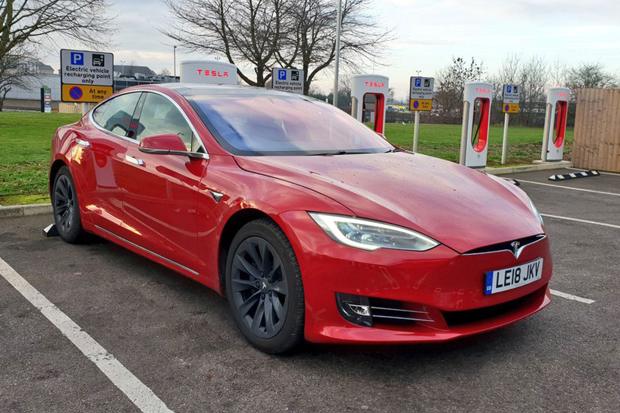
Date: 13 November 2018 | Current mileage: 4115 miles | Claimed range: 124 miles | Actual range: 121 miles
The electric car market is a strange one. The mainstream manufacturers seem to lag behind US tech firm Tesla, which launched its first electric car in 2008 and has now become the carmaker of choice for EV afficionados who wish to travel further afield on a single charge.
I've just spent a week with a Tesla Model S, and it's been an interesting experience. My car was the entry-level 75D, with a price tag of £70,850 before options. It's not a rival to the e-Golf, evidently, so it's pointless comparing the two. But as in an insight into Tesla's way of doing things, it's been quite the eye opener.
If you're a regular reader of my e-Golf updates, you'll know that my biggest bugbear of running an EV is the appaling state of the UK's charging network. Trying to find somewhere to charge is a hassle, and when you do it's often blocked by someone else or simply not working. It's also more fiddly than it ought to be (requiring different apps for different charge points) and it can be expensive (thanks Ecotricity).
Tesla knows this, so it's invested millions on its own network. A kind of private network of chargers that only Tesla drivers can use. During my brief time with the Model S, I needed a top up of electricity while travelling south on the M1. I used the in-car navigation to find a charger at Newport Pagnell services, and any fears about the chargers being blocked or not working were soon put to one side.
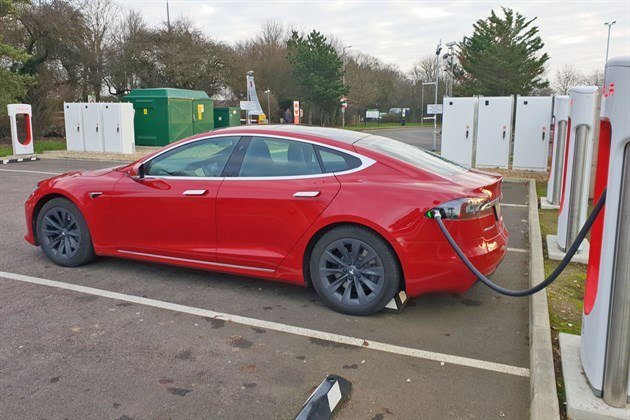
If only you could charge a Volkswagen e-Golf here...
The Superchargers, as Tesla calls them, are in their own little car park away from the hoi palloi - so there's little chance of someone in a petrol or diesel car blocking them. In the case of Newport Pagnell, there are 12 Superchargers. Yes, 12. They're never going to be all in use.
Plugging the Tesla in is super easy, too. No messing around with a phone app. Just plug it in and it charges. Tesla owners get 400kWh of free charging a year, and once all that's used up they'll automatically be billed 20p per kWh. For comparison. Ecotricity's Electric Highway currently costs 30p per kWh - and it's less reliable, slower, more difficult to use, you get the idea.
I plugged the Tesla in, went for a coffee and after around 30 minutes, Tesla's handy app told me I had enough electricity to cover an extra 170 miles - easily enough to reach my destination. There are downsides... at the time of writing, there are just 50 Supercharger locations in the UK - although this is set to increase to 71 by the end of 2019.
My time with the Tesla got me thinking about my perfect electric car. It wouldn't be the Tesla - for reasons I'll come onto in the review. It would, however, be a good car like the Volkswagen e-Golf, with the range of a Tesla and access to Tesla's network of Superchargers.
Goodbye, my electric friend
It's the end of our time with the Volkswagen e-Golf.

Date: 27 November 2018 | Current mileage: 4317 miles | Claimed range: 124 miles | Actual range: 118 miles
When I took delivery of the Volkswagen e-Golf six months ago, I was slightly sceptical about electric motoring. And, in many ways, it's done little to change that.
The infrastructure in the UK just isn't ready for wider adoption of electric vehicles. Finding chargers that work and aren't blocked by 'normal' cars is a hassle at best - and massively stressful at worst. We need more chargers, and they need to be somehow regulated. Ideally one card or phone app will provide access to all of them, or you should just be able to pay for charging using a contactless debit or credit card.
Part of this is our fault. When I took delivery of the e-Golf, I took on the mission of getting an electric charge point installed at our office. For various reasons, that's yet to happen - and I still can't really charge at home (without dangling a lead from a three-pin socket out of my window, anyway).
If I could charge an electric vehicle at home and/or work, life with an EV would be much easier. Most of my journeys are within the range of the e-Golf, and I've been surprised at how little I've had to split up a longer drive by stopping for some electricity.
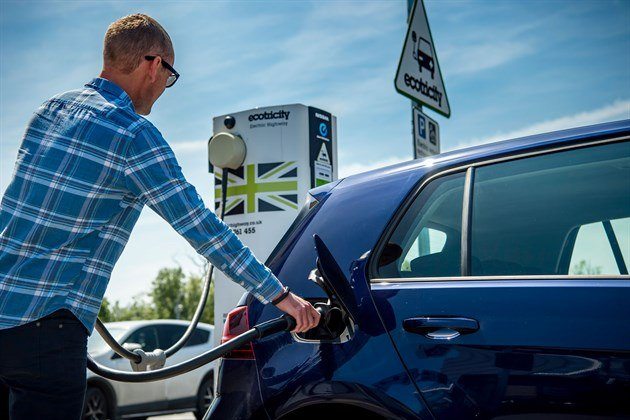
Yes, that is a working Ecotricity charger.
Officially, the e-Golf can cover 144 miles on a charge under the new WLTP fuel economy tests. And that's perfectly achievable, in my experience - it'll take some gentle driving (part of the fun of EV ownership), and summer weather helps. If you're very careful, the e-Golf is good for 160 miles.
While that was quite a respectable distance just six months ago, a lot has happened since then. The Hyundai Kona Electric has arrived, with its 279 mile range. Not to mention premium EVs like the Audi e-tron and Jaguar I-Pace, both capable of more than 240 miles on a charge.
Range and charging difficulties aside, I'm a huge fan of the Volkswagen e-Golf. It feels like a quality car, with a really decent interior (although the seats do make my back ache). The infotainment is up there with the best, and it's a really relaxing, easy car to drive.
So how do I move on from the e-Golf? Well, I've got another electric car lined up. Watch this space.
